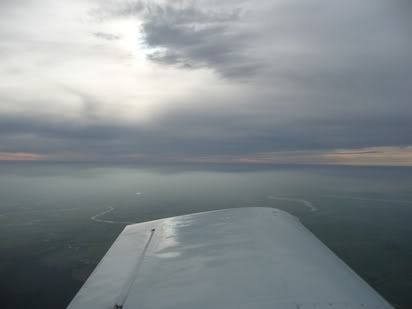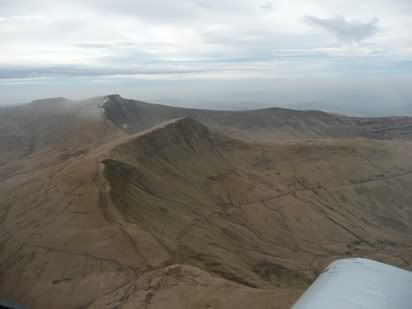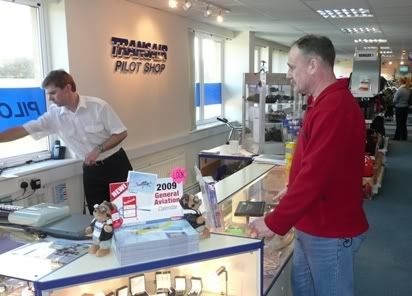The plane checked out fine but of course I had to fill up with fuel (I am sure the rest of the group swear they are the only one that ever fill up with fuel as well).
I thought I would do a local to take a look at Wales and the Brecon Beacons. We were given the 'long march of death' to C1 for 09 - Ron thought we were planning on taxying to Brecon! Power checks OK and off we went. The take off was fine in a minimal wind (3-4 kts), but I was surprised to hit a fair bit of chop on climbout until I topped a haze layer at 2500', when it very much smoothed out.

I headed SW for a bit, then west past Ross on Wye towards Abergavenny. We climbed to about 3800', well above the haze layer with a high overcast at, I would guess 15000' - nice and smooth up here, what a great view as we started to see some of the Welsh mountains with their peaks just sticking through the haze layer.
We got to Abergavenny and I decided that it was so nice, that I would wander up the valley to Brecon and check out the Brecon Beacons (much beloved of the SAS special forces, especially their selection process!).

We flew low over Fan-y-Big (Yes, it REALLY is called that - I couldn't make this stuff up!) and scraped over Pen-y-Fan - very exhilarating! I headed NE towards Hay on Wye. About 5 miles past Pen-y-fan, I hit quite a lot of chop, I had managed to get us into a bit of rotor, which surprised me as the wind on the ground was so light - lesson learned! I tightened my shoulder straps (to stop myself getting beaned on the head by a sharp downdraft) and started a climb to climb above it. What a schoolboy error!
Once at Hay, I set course for Credenhill barracks north of Hereford, avoiding the danger area, to pay my respects to the UK's finest! Then onto the Malverns as Rob wanted to use his new camera to get a photo of the beacon as his parents had walked up their onn their visit from Germany late last year.
Time was passing as I approached the end of my booking, so I headed for home via Tewkesbury. I picked up the ATIS and listened out on Glos Approach. It must have been one of those blips as they were as busy as hell, with 'standby's' being given out all over the place and muiltiple aircraft all converging on the Gloucester overhead.
This was made worse by a pompous windbag 'aerial survey' (he seemed very proud of this)chap who decided to refuel at Gloucester. Well of course he didn't get the ATIS first and his radio call on a very busy frequency was full of hugely timewasting 'if you could see you way clear to...' and 'at this moment, currently overhead (what other moment would it be?)' and 'thank you very much indeed sir' and loads of information that no one cared about, like his magnetic heading - oh my God I could go on. Nothing wrong with a bit of civility, but cut the cloth to fit! The frequency was backing up and this windbag obviously loved the sound of his own voice far too much to let anyone get a word in. He continued in this manner pretty much all the way to landing!
I orbited Tewkesbury waiting for the traffic to thin and was given a standby when I called. I spotted the Cotswolds Robin G-BGBA a few hundered feet belowas he also apparently orbited and headed into Gloucester. I lost him in the haze a few minutes before I was cleared to approach. I then started looking hard for G-BA as I could hear that he was also approaching the overhead and I knew I was quicker (even throttled back, I was doing 120kts vs the Robins like 95kts). I felt the hairs on the back of my neck bristle as I decided to drop the nose and do some sharp turns so I could see below me. I was glad I did, as I could now see G-BA in front and below me waggling his wings. He obviously saw me gaining and descending from his bubble canopy, but I couldn't see him because of my low wing and long nose (the aircraft, not mine). I turned and did an orbit for spacing and advised Glos Approach of my actions. It wasn't THAT close, but close enough that had I continued for a minute more, it would have been either very close or he would have been forced to take avoiding action.
I didn't ask for a direct join as they were way too busy and instead followed G-BA in keeping him in my sights at all times while trying to open the gap. I was given left hand circuits for 09 wil minimal wind. I reported crosswind as requested and just turned downwind when 'windbag' was using about three times the word count necessary to say he was at 1500' on his downwind direct join - oh joy, Mr. Pompous 500' above me and itching to descend. He was advised of me and I was by now late downwind. He gave a vague acknowledgement that he could see one aircraft ahead (wonderful! there were TWO aircraft ahead of him, be and G-BA in front of me - I just hoped iot was me he could see!).
I had G-BA in sight as I turned base and cranked in the flaps. I had gained a bit, but I guessed that G-BA was a student pilot under instruction and if so, the instructor would be aware of the traffic piled up behind him and get the student to land long and vacate the runway reasonably quickly. That is what happened as I called final and was thankfully given a 'continue'. There was enough of a gap for an easy land after and I was pleased that the controller offered this. I accepted and focused on landing.
Speed good, height good. Aim past the numbers as I don't want to hold up Mr Windbag or he will lock the tower frequency during a go-around! Held off and off, stall warner blaring, no flying left as we touched - good one. Keep the speed up and I was given a sensible vacate first right onto another runway rather than taxi to the end. This I did and held short of the 27 intersection to allow for a landing aircraft (as instructed).
I taxied back and shutdown. A very fun and satisfying 1.5 hour local. As I put the plane away, the owner of the lovely RV7 that will attempt the 1939 London - Cape Town record wandered into the hangar to do some work on his plane. I was in a hurry so didn't ask him about 'when', but I would love to know so I can be there to see him off - that is one hell of a record to go for.
A very nice flight as I packed the January group record sheets for my first stab at the group books. Next time, I think I'll try a landaway, maybe to Little Rissington as I haven't been there yet - more 'airfield collecting'!

